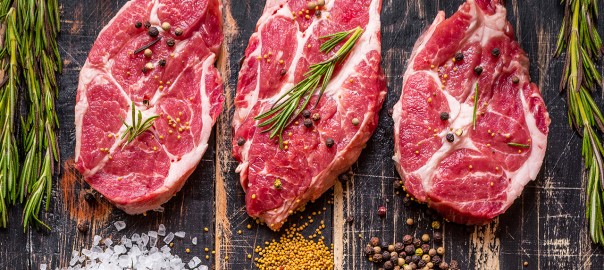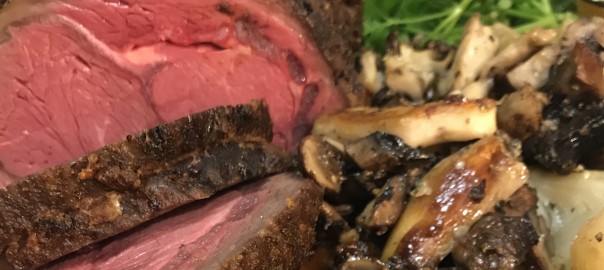People have been marinating meat for a long time. The word “marinade” is derived from the Latin term for seawater, aqua marina, a language evolution that is connected to the long-used practice of brining meat. Brining involves salt or saltwater and was primarily used to preserve meat so that it would last longer. It is also believed that brining was used to add flavor to poultry, fish and other meats.
While brining has been used in areas close to the sea, like areas bordering the Mediterranean, the process of marination is a global phenomenon. Whether done to add flavor or to tenderize meat, most marinades and meat sauces contain some acidic or enzymatic ingredients such as lemon juice, red wine, vinegar, ginger or fruits.
Southeast Asian marinades are sweet and savory, due to their propensity to include soy, ginger, and fruits. Marinades that come from tropical islands tend to rely heavier on fruits like pineapple and papaya, while marinades in western Asia rely more heavily on curry, a combination of turmeric, fresh ginger, chilis, and cumin.
Marinades and sauces of Asia — heavy on the soy
Soy sauce marinades
Many Asian marinades are sweet and savory, and, at times, spicy. Some of the more popular marinades from Asia are sauces used as condiments or added after cooking. A large number of marinades and sauces that derive from Asia are made from soybeans or their byproducts.
Soy sauce was first made in China and is believed to have first been created almost 2,000 years ago. Soy sauce is also derived from soybeans. It is fermented soybeans with grains, some salt/brine, and even mold cultures like Aspergillus oryzae or Aspergillus sojae. Although it originated in China, the use of soy sauce spread rapidly across southeast Asia and eventually made its way to Europe.
In Chinese cuisine, there are many different types of soy sauce that can be used in dishes featuring vegetables, pork, chicken, beef or fish. It is one of the most commonly used “spices” in food originating in China. In Japanese culture, soy sauce is prominent in what is known as the teriyaki style of cooking, which involves grilling or broiling glazed foods with the namesake teriyaki sauce that is a combination of soy sauce, sugar, and sake or mirin. Teriyaki-style and the simple marinade used for cooking is great with some chicken breasts (thinned of course), steaks, or pork tenderloin.
For other marinades, soy sauce is combined with sesame oil, sesame seeds, green onions, ginger, and sometimes fish sauce or hot chili sauce.
Soy sauce is not the secret ingredient for Chinese and Japanese cuisines only; its use is widespread across southeast Asia and is even a key ingredient in many traditional Hawaiian dishes.
Beyond China and Japan, soy sauce is used to marinate beef — with brown sugar, garlic, rice wine vinegar, ginger, sesame oil, and freshly ground black pepper — for Korean barbecue. In Indonesia and the Philippines, soy sauce is most commonly mixed with brown sugar and sometimes molasses and used as a marinade.
Soy sauce is used in marinades outside of Asia, as many steakhouses use soy sauce in some of their steak marinades across Europe and America.
Hoisin
Hoisin is a sweet and salty Chinese sauce is most often added as a glaze after cooking. Most commonly made with some combination of vinegar, soybeans, fennel seeds, red chilis, and minced garlic, it is used primarily as a dipping sauce or glaze. However, hoisin is also used in stir-frys and as a barbecue sauce.
As a marinade, Hoisin sauce is best for pork chops or fried or grilled chicken thighs or tenders. Some chefs experimenting with hoisin have combined it with fresh garlic cloves, chilis, and some sugar for a pre-cooking marinade for steak tips, tougher steaks like skirt steak, and even rib-eye.
Interestingly, the word hoisin is Chinese for “seafood,” yet it contains no fish and is used on other meats like pork, duck, and beef more prevalently than seafood. Fish sauce, which is very salty like soy sauce, is a completely different Chinese condiment.
Indian-inspired flavor
Heading west, you find fewer beef marinades and more sauces used for fish and chicken. One major reason for this is the influence of Hinduism — which prohibits eating cattle — in countries like India. Chicken dishes that derive from India, such as tikka masala and tandoori chicken, rely on marinades that combine a range of different spices with yogurt. Both tikka masala and tandoori are marinated in a yogurt-based sauce that can include ginger, chilis, cayenne, cumin, turmeric, minced garlic, and sometimes coconut and cinnamon.
These foods that rely on what are known as “curry” marinades or sauces are most often used on chicken or fish. However, because of religious beliefs, the eating of meat is forbidden in some circles, and so this popular sauce is also used in vegetable dishes.
Middle Eastern and Mediterranean marinades
In Mediterranean Asia, the shawarma cooking style is one of the most popular ways to cook meat like chicken, beef, turkey, or lamb. The meat for shawarma usually is marinated in spices similar to Indian cuisines; they use a marinade or rub that is some combination of turmeric, cayenne, garlic, cumin, paprika, and olive oil.
Once marinated, the meat is packed onto a spit and then grilled over a long period of time, such as an entire day. This style of cooking eventually gained popularity in Mediterranean Europe; if you’ve ever eaten a Greek gyro or kebab, you’ve had the meat cooked shawarma-style and combined with a yogurt-based sauce and fresh vegetables.
Interestingly, the shawarma method of cooking is also connected to Latin American cuisine. Al pastor — a popular Mexican pork dish used in tacos — is supposed to be cooked on a spit and is prepared in a shawarma-like marinade that often adds pineapple. How did that happen? Lebanese refugees who arrived in Mexico in the twentieth century combined the cuisine of their home with the fruit and spice influences they discovered in Latin America.
Try out an Asian marinade
Now that you have a whole plethora of different flavors to try with your grass-fed beef, free-range chicken, and heritage-breed pork this summer., it’s time to make like a true chef and get to mixing these amazing marinades together. Whether you let them marinate for an hour or an entire day, once you pull your Asian-influenced meat off the grill, you’ll thank us.
Check out some of our favorite recipes and cooking methods from ButcherBox Head Chef Yankel Polak for a deeper dive into Asian marinades.







